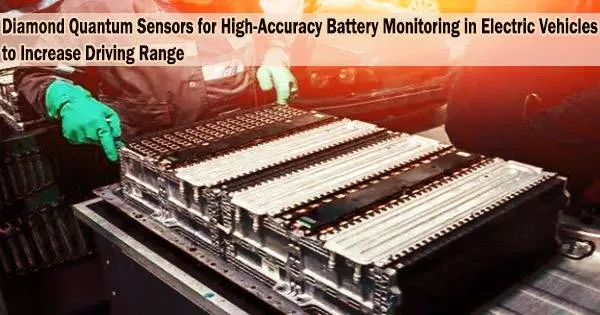A diamond quantum sensor prototype created as part of the MEXT Q-LEAP Flagship project with researchers from Tokyo Tech and Yazaki Corporation may finally put an end to the problem of battery usage inefficiency in electric vehicles caused by an erroneous battery charge measurement. The sensor can detect milliampere-level currents in a noisy environment and measure currents over a wide range, increasing detection accuracy from 10% to within 1%.
Electric vehicles (EVs) are becoming more and more well-liked as an environmentally beneficial substitute for traditional fuel automobiles. As a result, efforts are being made in research to create high-efficiency EV batteries.
However, EVs suffer from significant inefficiency as a result of incorrect battery charge predictions. Based on the battery’s current output, the charge state of an EV battery is determined. This gives an estimate of the cars’ remaining driving range.
The battery currents in EVs can frequently approach hundreds of amps. Commercial sensors, nevertheless, are unable to measure minute variations in current at milliampere levels. As a result, there is an estimated 10% uncertainty in battery charge.
What this means is that the driving range of EVs could be extended by 10%. This, in turn, would reduce inefficient battery usage.
We developed diamond sensors that are sensitive to milliampere currents and compact enough to be implemented in automobiles. Furthermore, we measured currents in a wide range as well as detected milliampere-level currents in a noisy environment.
Professor Mutsuko Hatano
Fortunately, a team of researchers from Japan, led by Professor Mutsuko Hatano from Tokyo Institute of Technology (Tokyo Tech), has now come up with a solution. The scientists described a detection method based on diamond quantum sensors that can measure strong currents typical of EVs and estimate the battery charge to within 1% accuracy in their work, which was published in Scientific Reports.
“We developed diamond sensors that are sensitive to milliampere currents and compact enough to be implemented in automobiles. Furthermore, we measured currents in a wide range as well as detected milliampere-level currents in a noisy environment,” explains Prof. Hatano.
Two diamond quantum sensors, which were positioned on either side of the busbar (an electrical connection for incoming and outgoing currents in the car), were used by the researchers to create a prototype sensor for their work.
The common noise picked up by both sensors was then eliminated using a method known as “differential detection,” leaving only the genuine signal. They were then able to distinguish a 10 mA little current from the surrounding noise as a result.
Next, the scientists traced the magnetic resonance frequencies of the quantum sensor over a bandwidth of 1 gigahertz using a hybrid analog-digital control of the frequencies produced by two microwave generators. This allowed for a large dynamic range (ratio of largest to smallest current detected) of ±1000 A. Additionally, it was established that a broad operating temperature range of – 40 to + 85 °C will cover most vehicular applications.
Last but not least, the group put this prototype through the WLTC (Worldwide Harmonized Light Vehicles Test Cycle), a benchmark test for EV energy consumption. The sensor exhibited the battery charge estimation accuracy within 1% by precisely tracking the charge/discharge current from -50 A to 130 A.
What are the implications of these findings?
Prof. Hatano remarks, “Increasing battery usage efficiency by 10% would reduce battery weight by 10%, which will reduce 3.5% running energy and 5% production energy of 20 million new EVs in 2030 WW. This, in turn, corresponds to a 0.2% reduction in CO2 emissions in 2030 WW transportation field.”





